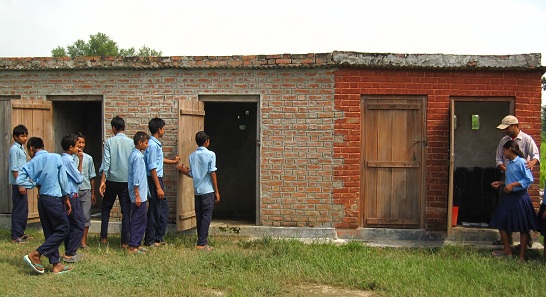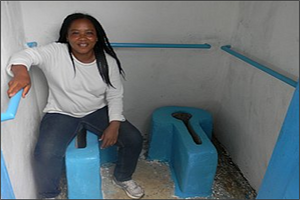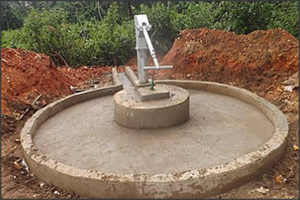Communal Latrines

This article covers the topic of communal latrines, also called institutional or school latrines. Much of the material in this article is based on project successes in the Sudan. This is a portion of the document of Technical Guidelines, outlining best practices for the development of the 14 types of water supply and sanitation facilities in the Sudan. Several of them are communal (multi-user) latrines.
Contents
Design and construction
Minimum standards
- For each health institution, ensure one sanitary latrine for 50 users, with a minimum of 3 squatting slabs; one for women, one for men and a separate one for the staff. A minimum space of width of 1.50m and length of 1.50m should be provided for every squatting space.
- Pits can be rectangular or circular, based on the soil type: Circular pits in loose formation and rectangular pits in hard and stable formation.
- Although a minimum distance of 15m is allowed in other countries, in Sudan it is recommended that pits are located at a minimum distance of 30 to 50 meters away from drinking water sources (tube wells and hand dug wells) depending on soil condition. The distance depends on hydro-geological conditions such as texture of the soil and groundwater depth and flow.
- When groundwater levels are high or when the soil is too hard to dig, the pit may have to be raised above ground level.
- Hand washing facilities must be provided beside each latrine in every rural health institution.
- A bin for hygienic disposal of sanitary materials must be provided in every chamber in the latrine.
Volume of the pit
Pits can be rectangular or circular. The volume of the pit may be calculated from the equation:
V = A + B
V = 0.3CPN + 0.75 x W x L x H …………for rectangular pit
V = 0.3CPN + N x 0.75 x H x П x D2/4 ...for series of circular pits
Where:
- A is volume of accumulated sludge and is equal to 0.3 CPN in m3.
- B is volume of free space above the sludge and is equal to (0.75 x W x L x H) for rectangular pit or (N x 0.75x H x П x D2/4) for circular pit in m3
- C is sludge accumulation rate or effective capacity per capita per year in m3/c/y. This figure varies from 0.04 to 0.093 and 0.045 to 0.0504. For Sudan situation it was arbitrarily taken as 0.06m3/c/y even though there are no available researched data for this.
- P is the number of visitors using the latrine.
- N is the number of years the pit is to be used before emptying.
- H is the most top depth of the pit which is 1 m in this case
- W is the width of the pit in meters
- L is the length of the pit in meters
- D is the diameter of a single pit in meters
The factor 0.3 has been introduced taking into considerations that such latrines are not going to be used during certain hours of the day, and a factor 0.75 has been introduced as the pit is to be emptied or filled with earth when the level of the waste in the pit has a free space of one quarter of a meter from the squatting level.
Superstructure
Pour Flush Latrine
Locally available materials like mud bricks, red bricks, etc. can be used for the construction of the walls of the superstructure. The roof can be also be constructed from durable local materials. The type of material can be chosen by the users so long as it provides privacy, convenience and comfort. A minimum of three squatting spaces each of dimension 150cm by 150cm should be provided.
The squatting space should be fitted with a pan attached with a U-water seal. The pan could be of either cement concrete, ceramics or fibre reinforced plastic.
Improved Traditional Pit Latrine
The superstructure can be constructed from locally available and durable material like bricks, and should provide privacy, convenience and comfort to the user. A minimum of 150cm x 150cm area per squatting space should be provided. Plastic sheeting can be considered for construction of the superstructure during emergencies.
Vent pipe
PF Latrine: There is no need for a vent pipe as gases will diffuse into the soil.
ITP Latrine: The installation of a vent pipe outside of the superstructure is recommended to minimize the odour of foul gases from the pit. The vent pipe can be a PVC pipe of minimum diameter 100mm and should be dark in colour. The vent pipe should extend a minimum of 500mm – 1000 mm above the highest part of the roof, and the top should be covered with mesh wire.
| Read about more technical guidelines in the full PDF document, including mobilizing stakeholders, latrine selection, and management of the latrines. |
Field experiences
The following projects are building or using communal, institutional, or school latrines.
 WaterAid Rural WASH Project |
 Integrated Community Water and Hygiene |
 Basic Sanitation for Loja Province |
Links
5.7 Communal aqua-privies. UNICEF.


